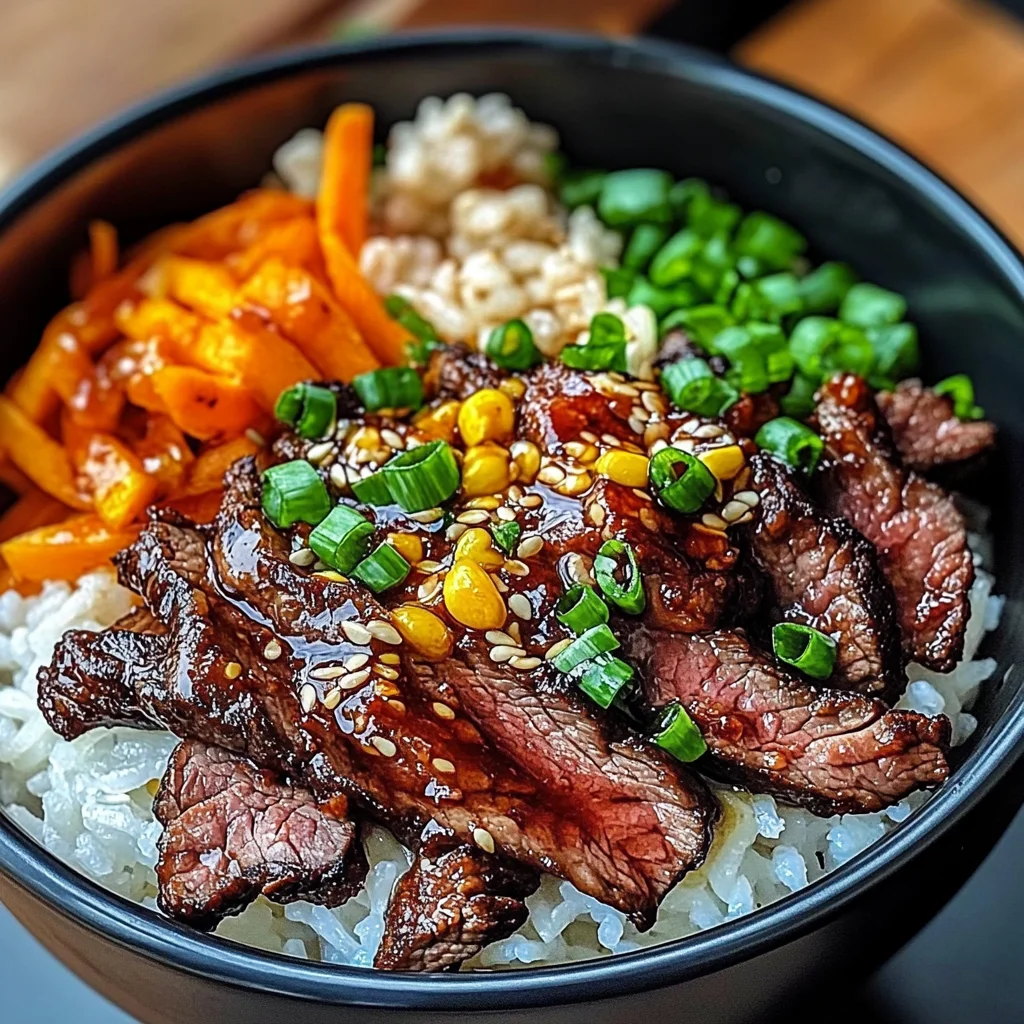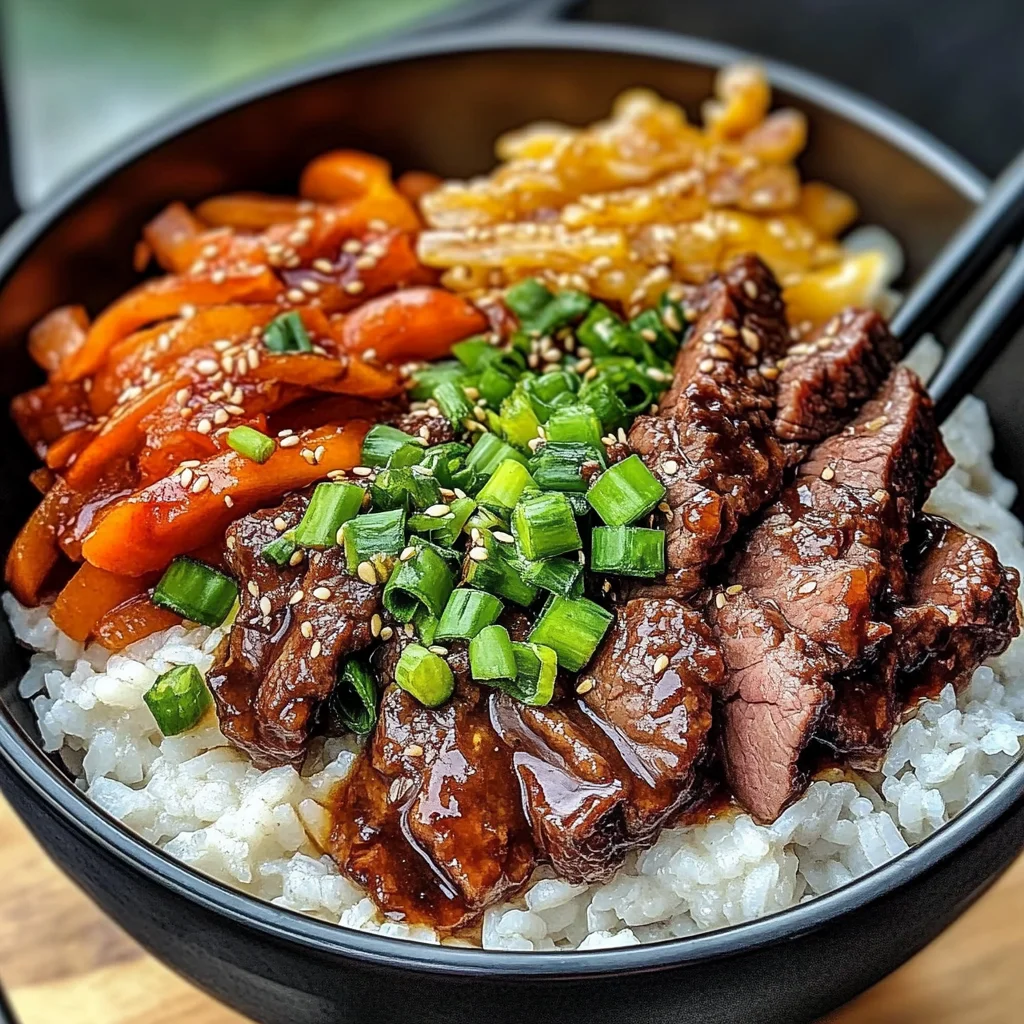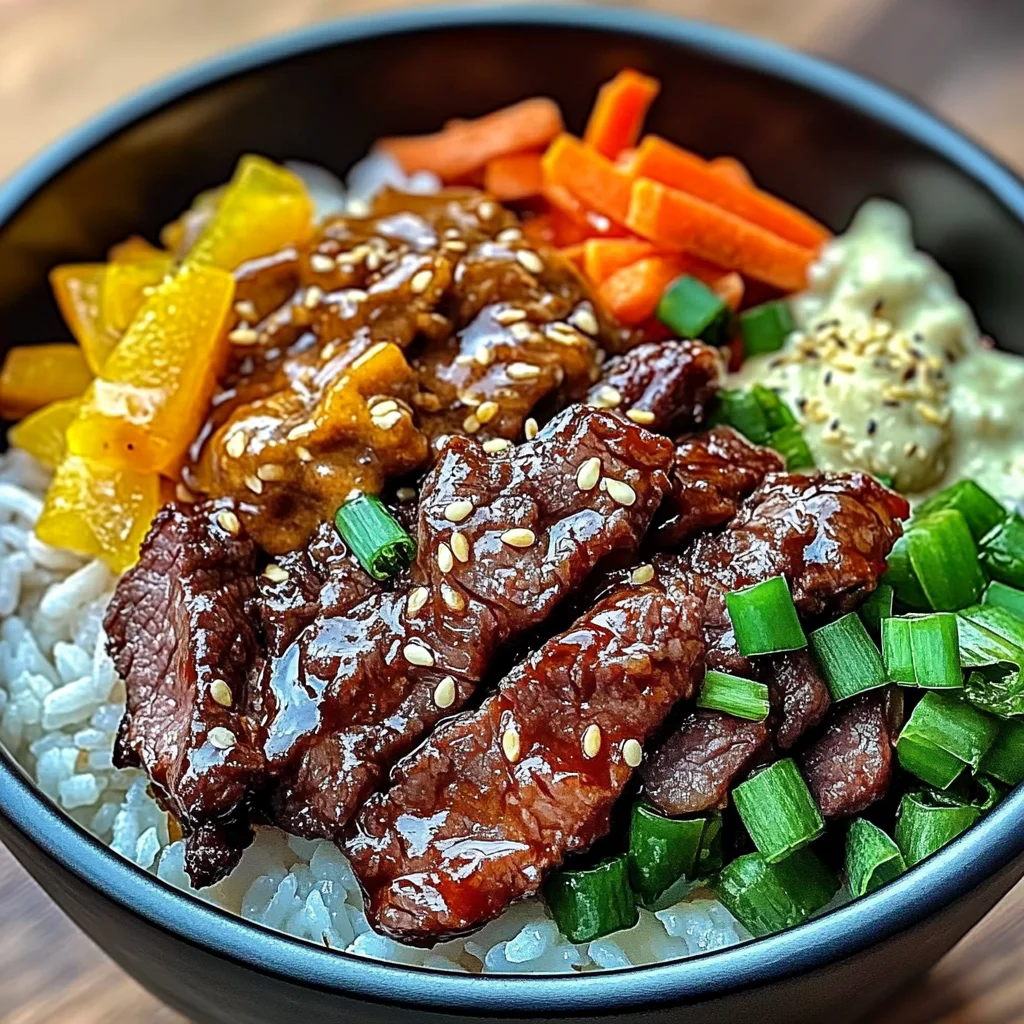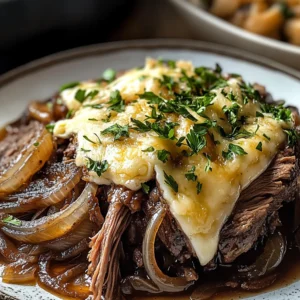Korean Beef Bowls are a delightful meal that brings the flavors of Korea right to your table. This dish is perfect for weeknight dinners, meal prep, or entertaining guests. With its tender beef, vibrant vegetables, and savory sauce, this recipe stands out for its rich taste and easy preparation.

Jump to:
- Why You’ll Love This Recipe
- Tools and Preparation
- Essential Tools and Equipment
- Importance of Each Tool
- Ingredients
- For the Beef Marinade
- For the Vegetables
- For Serving
- How to Make Korean Beef Bowls
- Step 1: Prepare the Marinade
- Step 2: Marinate the Beef
- Step 3: Cook the Beef
- Step 4: Sauté the Vegetables
- Step 5: Add Bell Peppers
- Step 6: Combine Beef with Vegetables
- Step 7: Serve
- Step 8: Garnish
- How to Serve Korean Beef Bowls
- Over Rice
- With Lettuce Wraps
- Topped with Kimchi
- As a Stir-Fry Bowl
- With Avocado Slices
- Garnished with Fresh Herbs
- How to Perfect Korean Beef Bowls
- Best Side Dishes for Korean Beef Bowls
- Common Mistakes to Avoid
- Storage & Reheating Instructions
- Refrigerator Storage
- Freezing Korean Beef Bowls
- Reheating Korean Beef Bowls
- Frequently Asked Questions
- What type of beef is best for Korean Beef Bowls?
- Can I customize my Korean Beef Bowls?
- How do I make Korean Beef Bowls spicier?
- Are Korean Beef Bowls healthy?
- How long does it take to prepare Korean Beef Bowls?
- Final Thoughts
- 📖 Recipe Card
Why You’ll Love This Recipe
- Quick to Prepare: This recipe can be made in under 30 minutes, making it ideal for busy weeknights.
- Flavor Packed: The marinade combines soy sauce, sesame oil, and spices for a deliciously savory experience.
- Versatile Ingredients: Feel free to add your favorite vegetables or adjust the spice level to suit your taste.
- Meal Prep Friendly: Leftovers store well in the fridge and can be reheated for a quick lunch or dinner.
- Family Favorite: The combination of beef and colorful veggies appeals to both kids and adults alike.
Tools and Preparation
To make these Korean Beef Bowls, you’ll need some essential kitchen tools. Having the right equipment can make the cooking process smoother and more enjoyable.
Essential Tools and Equipment
- Skillet or Wok
- Medium Bowl
- Whisk
- Cutting Board
- Knife
Importance of Each Tool
- Skillet or Wok: Ideal for stir-frying the beef and vegetables quickly while retaining their textures.
- Medium Bowl: Perfect for mixing the marinade ingredients without creating a mess.
- Whisk: Ensures all marinade ingredients blend thoroughly for an even flavor distribution.

Ingredients
For the Beef Marinade
- 1 lb beef sirloin, thinly sliced against the grain
- 1/2 cup soy sauce
- 1/4 cup brown sugar
- 2 tablespoons sesame oil
- 2 tablespoons rice vinegar
- 1 tablespoon minced garlic
- 1 tablespoon grated ginger
- 1 teaspoon red pepper flakes (or more, to taste)
For the Vegetables
- 1 medium onion, thinly sliced
- 2 carrots, julienned or thinly sliced
- 2 bell peppers, thinly sliced (any color)
For Serving
- 1 cup cooked rice, for serving
- 2 scallions, thinly sliced, for garnish
- Sesame seeds, for garnish (optional)
How to Make Korean Beef Bowls
Step 1: Prepare the Marinade
In a medium bowl, whisk together soy sauce, brown sugar, sesame oil, rice vinegar, minced garlic, grated ginger, and red pepper flakes until well combined.
Step 2: Marinate the Beef
Add the thinly sliced beef to the marinade. Stir well to ensure each piece is coated evenly. Allow it to marinate for at least 30 minutes; if time permits, marinate up to 2 hours in the refrigerator.
Step 3: Cook the Beef
Heat a large skillet or wok over medium-high heat. Add the marinated beef in batches if necessary. Cook while stirring occasionally until browned and cooked through (about 5-7 minutes). Remove from skillet and set aside.
Step 4: Sauté the Vegetables
In the same skillet, add sliced onions and carrots. Cook while stirring occasionally until softened (about 3-5 minutes).
Step 5: Add Bell Peppers
Add bell peppers to the skillet and cook for another 2-3 minutes until they are slightly softened but still crisp.
Step 6: Combine Beef with Vegetables
Return cooked beef to the skillet with vegetables. Stir everything together and heat through for another minute.
Step 7: Serve
Serve the beef and vegetable mixture over a bed of cooked rice.
Step 8: Garnish
Top with thinly sliced scallions and sesame seeds if desired. Enjoy your flavorful Korean Beef Bowls!
How to Serve Korean Beef Bowls
Korean Beef Bowls are a delicious and versatile dish that can be enjoyed in many ways. Whether you’re serving them for a family dinner or a casual gathering, here are some great serving suggestions to elevate your meal.
Over Rice
- Serve the beef and vegetables over a generous bed of cooked rice for a hearty meal. White or brown rice works well to soak up the flavors.
With Lettuce Wraps
- Use large lettuce leaves to create fresh wraps. Fill each leaf with the beef mixture and enjoy them as a fun, interactive dish.
Topped with Kimchi
- Add a side of kimchi for an authentic touch. The tangy and spicy flavor of kimchi complements the savory beef beautifully.
As a Stir-Fry Bowl
- Toss everything together in a bowl with additional veggies like snap peas or broccoli for a colorful stir-fry experience.
With Avocado Slices
- Top your Korean Beef Bowls with creamy avocado slices. This adds richness and balances the dish’s flavors.
Garnished with Fresh Herbs
- Enhance the presentation by garnishing with fresh herbs like cilantro or basil. They add a pop of color and freshness to your bowls.
How to Perfect Korean Beef Bowls
Creating the perfect Korean Beef Bowls requires attention to detail and some helpful tips. Here are some ways to elevate your dish:
- Marinate Longer: For deeper flavor, allow the beef to marinate for 1-2 hours instead of just 30 minutes.
- Use High Heat: Cooking on medium-high heat helps achieve that wonderful sear on the beef, adding texture.
- Balance Flavors: Taste the marinade before adding the beef; adjust sweetness or spiciness as needed for your preference.
- Add Veggies Wisely: Include vegetables that cook quickly so they stay crisp and vibrant.
- Serve Fresh: Enjoy Korean Beef Bowls immediately after cooking for the best flavor and texture.
- Experiment with Toppings: Don’t hesitate to try different garnishes like crushed peanuts or chili oil for added depth.
Best Side Dishes for Korean Beef Bowls
Pairing side dishes with your Korean Beef Bowls can enhance your meal experience. Here are some excellent options:
- Steamed Broccoli: Bright green broccoli provides a nutritious contrast and complements the flavors well.
- Spicy Cucumber Salad: This refreshing salad adds crunch and spice, balancing out the richness of the beef.
- Roasted Sweet Potatoes: These offer a sweet contrast to savory flavors while being filling.
- Miso Soup: A warm miso soup serves as a comforting starter that pairs nicely with Asian flavors.
- Pickled Radishes: The tangy bite of pickled radishes cleanses the palate between bites of beef.
- Edamame Beans: Steamed edamame makes for a great finger food option that’s both healthy and satisfying.
- Fried Rice: A flavorful fried rice can serve as an alternative base if you want something different from plain rice.
- Grilled Zucchini Skewers: Lightly seasoned grilled zucchini adds a smoky flavor that’s delicious alongside beef dishes.
Common Mistakes to Avoid
When making Korean Beef Bowls, it’s easy to overlook some key steps that can affect the final dish. Here are common mistakes to avoid for the best results.
Over-marinating the beef: While marinating is essential, leaving the beef too long can make it mushy. Stick to 30 minutes to 2 hours for optimal texture.
Using low-quality soy sauce: Not all soy sauces are created equal. Choose a high-quality soy sauce for deeper flavor and avoid overly salty options.
Skipping the resting time: Allowing your cooked beef to rest before serving helps retain juices. Don’t rush this step; a few minutes makes a huge difference.
Neglecting vegetable prep: Ensure your vegetables are sliced uniformly for even cooking. Uneven pieces can lead to some being overcooked while others remain raw.
Serving without garnishes: Garnishes like scallions and sesame seeds add flavor and visual appeal. Don’t skip them; they elevate your dish significantly.

Storage & Reheating Instructions
Refrigerator Storage
- Store leftover Korean Beef Bowls in an airtight container.
- They will keep well in the refrigerator for 3 days.
Freezing Korean Beef Bowls
- For longer storage, freeze the beef and veggies separately from the rice.
- Use freezer-safe containers or heavy-duty freezer bags.
- Consume within 2-3 months for best quality.
Reheating Korean Beef Bowls
Oven: Preheat to 350°F (175°C) and cover with foil. Heat for about 15-20 minutes until warmed through.
Microwave: Place in a microwave-safe dish, cover with a damp paper towel, and heat in 1-minute intervals until hot.
Stovetop: Warm in a skillet over medium heat, adding a splash of broth if needed to prevent sticking. Stir occasionally until heated through.
Frequently Asked Questions
Here are some common questions about making Korean Beef Bowls that may help clarify any doubts you have.
What type of beef is best for Korean Beef Bowls?
Sirloin or flank steak works best due to their tenderness when sliced thinly against the grain.
Can I customize my Korean Beef Bowls?
Absolutely! Feel free to add other vegetables like zucchini or mushrooms, or adjust seasonings to suit your taste.
How do I make Korean Beef Bowls spicier?
To increase heat, simply add more red pepper flakes during marination or serve with spicy sauce on the side.
Are Korean Beef Bowls healthy?
Korean Beef Bowls can be healthy depending on portion sizes and ingredients used. Opt for lots of vegetables and lean cuts of meat for a nutritious meal.
How long does it take to prepare Korean Beef Bowls?
The entire process can take about 45 minutes, including marinating time and cooking, making it a quick weeknight dinner option.
Final Thoughts
Korean Beef Bowls offer a delicious blend of flavors and textures that everyone will love. They’re also incredibly versatile; you can easily customize them with your favorite vegetables or spice levels. Give this recipe a try for an easy yet satisfying meal!
Did You Enjoy Making This Recipe? Please rate this recipe with ⭐⭐⭐⭐⭐ or leave a comment.
📖 Recipe Card
Print
Korean Beef Bowls
- Total Time: 45 minutes
- Yield: Serves 4
Description
Indulge in the vibrant flavors of Korean Beef Bowls, a delightful dish that brings the essence of Korea straight to your dining table. This recipe features tender beef marinated in a rich blend of soy sauce and spices, complemented by colorful vegetables for a nutritious and satisfying meal. Perfect for busy weeknights or meal prepping, these bowls are quick to prepare and customizable to suit your family’s tastes. Serve over rice and garnish with fresh herbs for an unforgettable dining experience.
Ingredients
- 1 lb beef sirloin, thinly sliced
- 1/2 cup soy sauce
- 1/4 cup brown sugar
- 2 tablespoons sesame oil
- 2 tablespoons rice vinegar
- 1 tablespoon minced garlic
- 1 tablespoon grated ginger
- 2 carrots, julienned
- 2 bell peppers, thinly sliced
- 1 medium onion, thinly sliced
- Cooked rice for serving
Instructions
- In a medium bowl, whisk together soy sauce, brown sugar, sesame oil, rice vinegar, garlic, ginger, and red pepper flakes until well combined.
- Add sliced beef to the marinade, ensuring each piece is coated. Marinate for at least 30 minutes or up to 2 hours in the refrigerator.
- Heat a skillet or wok over medium-high heat and cook the marinated beef until browned (5-7 minutes). Remove from skillet.
- In the same skillet, sauté onions and carrots until softened (3-5 minutes), then add bell peppers and cook until slightly crisp (2-3 minutes).
- Combine beef with vegetables in the skillet and heat through for another minute.
- Serve over cooked rice and garnish with scallions and sesame seeds if desired.
- Prep Time: 30 minutes
- Cook Time: 15 minutes
- Category: Main
- Method: Stir-frying
- Cuisine: Korean
Nutrition
- Serving Size: 1 serving
- Calories: 450
- Sugar: 15g
- Sodium: 900mg
- Fat: 20g
- Saturated Fat: 4g
- Unsaturated Fat: 14g
- Trans Fat: 0g
- Carbohydrates: 45g
- Fiber: 3g
- Protein: 25g
- Cholesterol: 80mg





